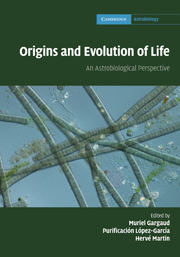Book contents
- Frontmatter
- Contents
- List of contributors
- Foreword
- Preface
- Part I What is life?
- Part II Astronomical and geophysical context of the emergence of life
- 6 Organic molecules in the interstellar medium
- 7 Cosmochemical evolution and the origin of life: insights from meteorites
- 8 Astronomical constraints on the emergence of life
- 9 Formation of habitable planets
- 10 The concept of the galactic habitable zone
- 11 The young Sun and its influence on planetary atmospheres
- 12 Climates of the Earth
- Part III The role of water in the emergence of life
- Part IV From non-living systems to life
- Part V Mechanisms for life evolution
- Part VI Life in extreme conditions
- Part VII Traces of life and biosignatures
- Part VIII Life elsewhere?
- Index
8 - Astronomical constraints on the emergence of life
from Part II - Astronomical and geophysical context of the emergence of life
Published online by Cambridge University Press: 04 February 2011
- Frontmatter
- Contents
- List of contributors
- Foreword
- Preface
- Part I What is life?
- Part II Astronomical and geophysical context of the emergence of life
- 6 Organic molecules in the interstellar medium
- 7 Cosmochemical evolution and the origin of life: insights from meteorites
- 8 Astronomical constraints on the emergence of life
- 9 Formation of habitable planets
- 10 The concept of the galactic habitable zone
- 11 The young Sun and its influence on planetary atmospheres
- 12 Climates of the Earth
- Part III The role of water in the emergence of life
- Part IV From non-living systems to life
- Part V Mechanisms for life evolution
- Part VI Life in extreme conditions
- Part VII Traces of life and biosignatures
- Part VIII Life elsewhere?
- Index
Summary
Before the Solar System
The formation of the Sun and stars
The Sun is somewhat a late-comer in our Galaxy, the Milky Way. It was born 4.6 Gyr ago (4.5685 Gyr ± 0.5 Myr, to be precise, from the decay of specific radioactive heavy elements in the most primitive meteorites – see below). This is to be compared with the age of the Universe, constrained by the best theoretical fits to the observed spatial fluctuations of the ‘cosmic background radiation’ to be 13.7 Gyr after the Big Bang, within 2%. When galaxies form is less certain, but current estimates give a time lapse of less than 1 Gyr after the Big Bang – implying that our own Galaxy has an age of over 12.7 Gyr and that the Sun was born over 8.1 Gyr later. So at the time the Sun formed, our Galaxy was already sufficiently evolved by successive generations of stars that it presented no major differences with the one we observe today. Therefore, we can safely derive conclusions about the distant birth of the Sun from observations of contemporary young stars.
In a nutshell, from various observations we know that bright nebulae, including some famous ones like Orion, the Eagle or Carina nebulae, are ‘stellar nurseries’ (Figure 8.1), where stars like the Sun form in clusters of thousands of low- to intermediate-mass stars. A few massive stars, like the Orion Trapezium, for which the highest mass is of order 45 Mʘ also form in these stellar nurseries.
- Type
- Chapter
- Information
- Origins and Evolution of LifeAn Astrobiological Perspective, pp. 118 - 135Publisher: Cambridge University PressPrint publication year: 2011



